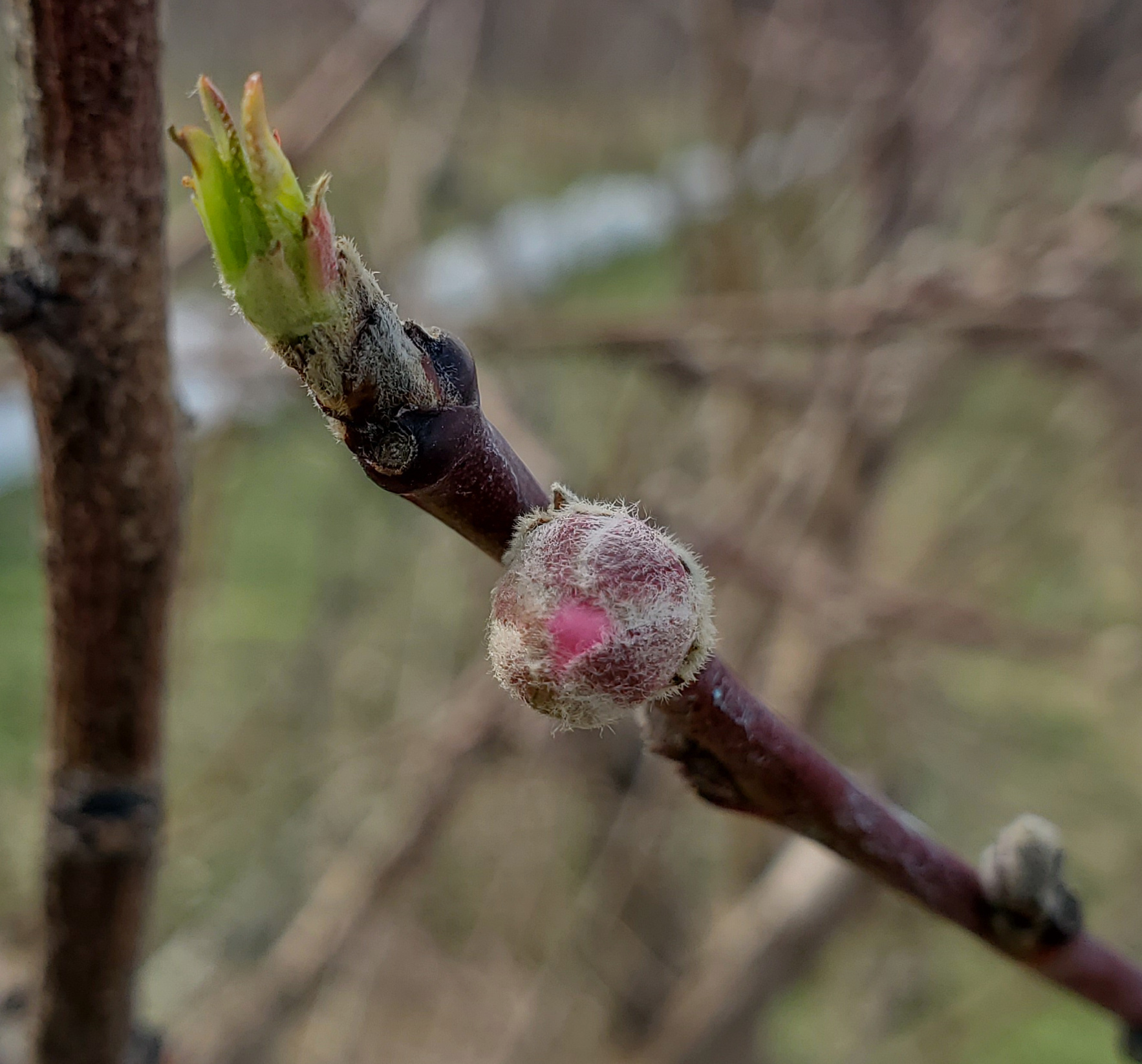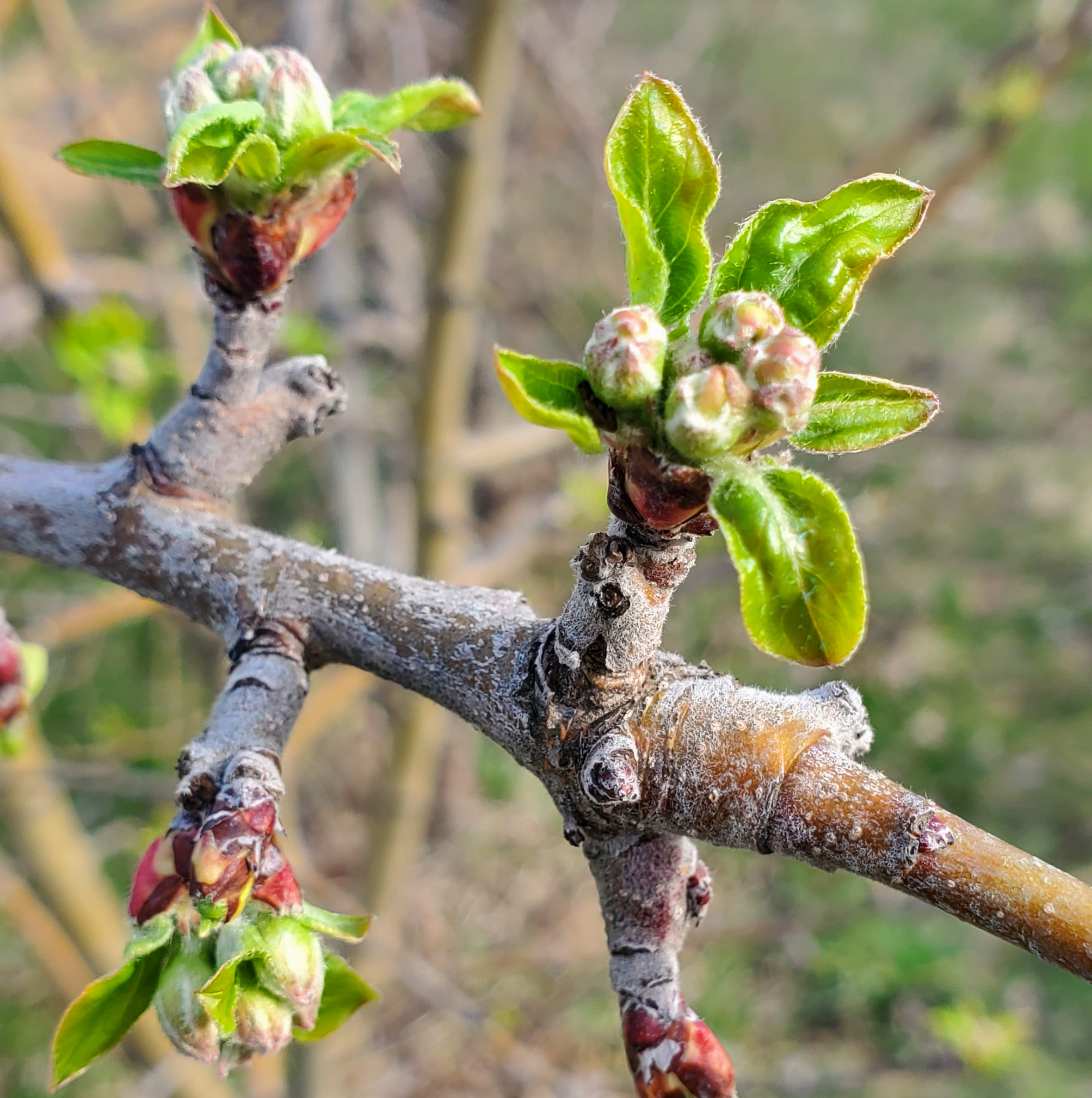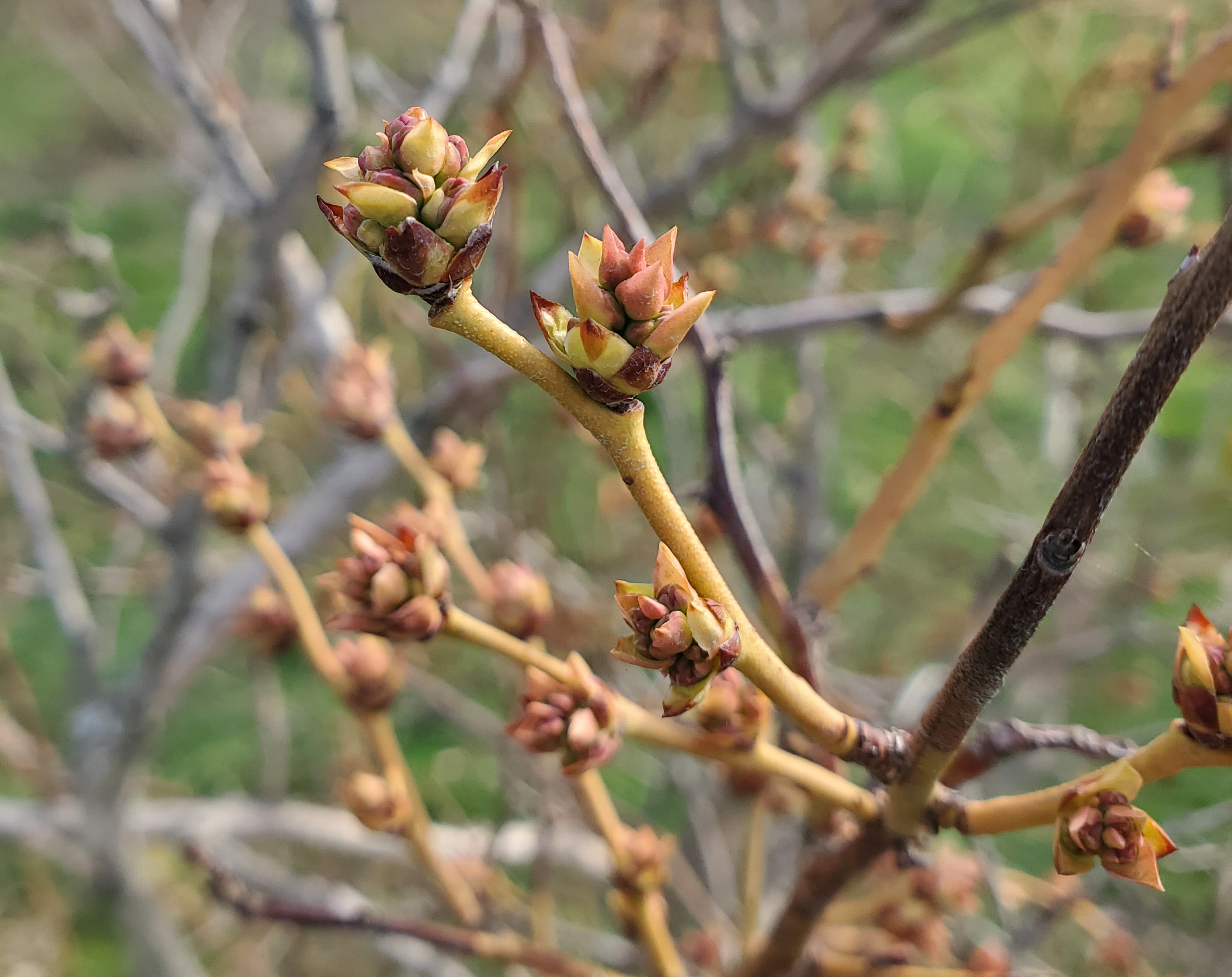Southwest Michigan fruit update – April 6, 2021
March was warm. Fruit crops are moving.

Winter
The winter of 2020-2021 was mild. Temperatures seldom dropped below 10 degrees Fahrenheit and most plants had completed their chilling requirements by early January for peaches and grapes. Other fruit crops with a higher chilling requirement such as apples, blueberries, cherries, pears and plums reached this point by late January. A single deep freeze event occurred the morning of Feb. 17 when temperatures dropped down from 0 to -10 F. No significant damage from this late winter cold was reported.
Early winter precipitation was above average. Since the first of the year, however, precipitation is half of normal. Soils are dry. Early ornamentals started coloring up in early March. Some fruit crop buds were swelling in mid-March.
Below are the growing degree days (GDD) for the Southwest Michigan Research and Extension Center (SWMREC) near Benton Harbor, Michigan, for the last 20 years. There are two tables, one from Jan. 1 to March 1 (January and February) and the other from March 1 to March 31. The GDD totals for January and February also indicate that, although not very cold, we had little warm weather in the winter. Compare the 2021 numbers to the averages for the last 20 years and you can see that we are a now little ahead of average.
|
GDD from Jan. 1 to March 1 at SWMREC for the last 20 years. | |||
|---|---|---|---|
|
Year |
Base 42 F |
Base 45 F |
Base 50 F |
|
Ave |
25 |
15 |
6 |
|
2021 |
3 |
1 |
0 |
|
GDD from March 1 to April 4, 2020, at SWMREC for the last 20 years. | |||
|---|---|---|---|
|
Year |
Base 42 F |
Base 45 F |
Base 50 F |
|
Ave |
116 |
85 |
48 |
|
2021 |
198 |
152 |
90 |
|
2020 |
96 |
64 |
28 |
|
2019 |
53 |
32 |
12 |
|
2018 |
18 |
8 |
1 |
|
2017 |
126 |
86 |
42 |
|
2016 |
174 |
128 |
71 |
|
2015 |
81 |
56 |
29 |
|
2014 |
31 |
18 |
8 |
|
2013 |
25 |
14 |
4 |
|
2012 |
408 |
338 |
235 |
|
2011 |
50 |
32 |
17 |
|
2010 |
206 |
156 |
94 |
|
2009 |
125 |
88 |
44 |
|
2008 |
48 |
30 |
13 |
|
2007 |
227 |
177 |
109 |
|
2006 |
92 |
67 |
37 |
|
2005 |
95 |
72 |
43 |
|
2004 |
119 |
85 |
47 |
|
2003 |
168 |
126 |
72 |
|
2002 |
42 |
27 |
12 |
|
2001 |
48 |
28 |
10 |
March weather
Temperatures for most of March were warm with highs generally above average, occasionally in the mid- to upper 60s. Overnight temperatures have been in the 20s and 30s. The coldest morning since mid-February was this past Friday, April 2, when low temperatures were 13 to18 F in the fruit growing areas with lower temperatures further from Lake Michigan. The table below shows how warm March was. Normally we would pick up 100 GDD base 42 and 60 base 50 in March.
|
Southwest Michigan GDD summary from March 1 - April 4, 2021 | |||
|---|---|---|---|
|
Station |
GDD 42 F |
GDD 45 F |
GDD 50 F |
|
Benton Harbor (SWMREC) |
179 |
136 |
79 |
|
Lawton (Lawton) |
179 |
135 |
77 |
|
Fennville (TNRC) |
142 |
105 |
59 |
|
Average for the SW region |
174 |
132 |
77 |
April began with a classic radiation freeze on Friday April 2, with low temperatures dropping into the mid and upper teens. The forecast for the upcoming week is warmer and wetter. Highs early in the week should be in the mid- to upper 70s, dropping to the low 60s later in the week. Lows will be in the 40s and 50s.
Rain is expected from Thursday through Saturday. Overall rain amounts are expected to be near 1.5 inches over the next week. The medium range forecast for the rest of April is for warmer than average weather. This continues through the rest of spring.
Tree fruit
Several episodes of warm weather since mid-March have accelerated tree development. Most tree fruit are past the swollen bud stage to the point where they could be damaged with temperatures below 20 F, but most would need to go down into the low teens for severe damage. Low temperatures for the morning April 2 caused damage to apricots, sweet cherries, some tart cherries and king bloom in apples in some locations, but crop prospects are still good. Here is a link to tree fruit bud critical temperatures and another with pictures.
Soils are dry. Some orchard blocks are looking poor due to winter damage over the last five years. Check blocks for evidence of San Jose scale on branches to determine the need for oil sprays. For those interested in putting up mating disruption for moth species, this is a good time to do it. Oriental fruit moth biofix is predicted this week. There are a few weeks before codling moth and leafroller biofixes.
Apricots are beginning or at full bloom, depending on variety.
Peaches and nectarines are at green calyx, red calyx or first pink, depending on variety and location. The rains two weeks ago were sufficient for peach leaf curl infections in some sites. Infections require 10-plus hours of wetting with temperatures in the range of 46 to 55 F. Even if an early spray for this disease has not been applied, application now can help suppress additional infections when these weather conditions occur after bud swell, but this window is rapidly closing. Low levels of copper also suppress bacterial spot populations.

In cherries, buds are at side green or green tip. Damage from the freeze on April 2 caused damage at some inland sites, leaving others nearby untouched. We are still in the window when copper sprays can be safely applied to sweet cherries at a lesser rate than dormant applications. In addition to copper sprays, pruning during dry conditions helps suppress bacterial canker in cherries.
In plums, Japanese plum buds are at tight cluster with European plums lagging behind at green tip. Prune out black knot and dispose of the knots by burning or removing from the orchard. Sanitation is very important in managing this disease.
Apple buds are at early tight cluster for early varieties such as Zestar and 0.25 to 0.5 inches green for Idared, Red Delicious and McIntosh. Some damage from last Friday’s freeze has been seen on king bloom in eastern Van Buren County. Local monitoring sites showed significant apple scab ascospore catches during the March 23-24 wetting period and the weather conditions may have be sufficient for a few sites for an infection period, especially in the Lawrence and Lawton areas. Scab sprays will be needed to protect against future rains such as those predicted the coming week.
Copper sprays can provide early scab control and fire blight suppression. The combination of lesser rates of copper and mancozeb allows good protection and less risk of copper phytotoxicity. Protectants are preferred over systemic fungicides at this time of year for scab control.

Pears are at bud burst.
Small fruit
Grapes are beginning to grow. Concord and other varieties are at scale crack indicating the beginning of bud swell.
Blueberry flower buds are swollen and leaf buds are showing green near the shoot tips. With the rain forecast for later this week, growers will want to protect against mummy berry. Growers still have time to apply copper, Sulforix or lime sulfur products to suppress early season diseases.

Strawberries have greened up and new leaves are emerging from the crown. The flower trusses are still in the ground and safe from freezing injury down to about 10 F. Overwintering mulches should be removed and raked between the rows. Some growers are putting out floating row covers. Growers should have their freeze protection systems checked and functional.
Brambles show some movement with swollen buds. Dormant pruning should be completed soon. In summer bearing raspberries, last year’s primocanes should be headed (cut back) to the desired height and any remaining floricanes from last year should be removed. Fall bearing raspberries should be cut or mowed to the ground. Lime sulfur treatments for anthracnose can still be applied until new leaves begin to unfold.
Miscellaneous crops
Hops are emerging from the crown. Most shoots are 1-2 inches. Preseason herbicide treatments should be complete. Mildew and spider mite scouting should begin soon.
Chestnuts show no movement.
Upcoming meetings
Our regular Southwest Michigan Monday Fruit IPM Updates are available online. You need to register to receive the Zoom link and password for these meetings. The webinars are free and one pesticide applicator credit is available for each meeting. We had over 70 growers attending our Monday meetings last year.
The Statewide Spring Tree Fruit Webinar series will be the first two weeks of April. One topic will be discussed over the lunch hour each day. You need to register to receive the Zoom link and password for these presentations. The webinars are free of charge and one pesticide applicator credit is available for each meeting.
Related articles
- Freeze damage depends on tree fruit stage of development
- Using Enviro-weather’s regional overnight temperature report during cold events
- Treat peach leaf curl now
- Managing bacterial canker in sweet cherries: What are the options?
- Early insect control with horticultural oils
- Dormant oil for tree fruit pest management in 2015
- Scouting and management of mummy berry in blueberries



 Print
Print Email
Email




